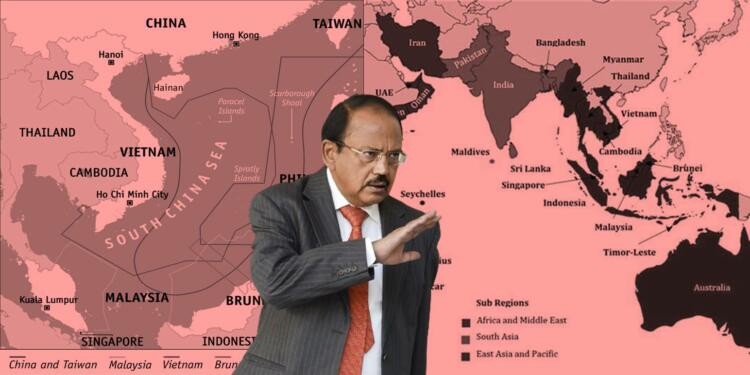There was a time when the Indian Ocean and India used to be synonymous for people. The perception was shaped by the Indian Navy’s strong presence in the region. However, over the last few decades, various other factors have registered their presence in the region. There is a South China Sea-type race of domination going on. But, the Modi government does not seem to be in the mood to allow any kind of misadventure.
Doval’s reality check on the Indian Ocean
National Security Adviser Ajit Doval has made it crystal clear to the Security agencies that India’s interests in the Indian Ocean need to be protected at any cost. NSA Doval was speaking at the first meeting of the Multi-Agency Maritime Security Group (MAMSG). The meeting was chaired by Vice Admiral G Ashok Kumar (retd), country’s first National Maritime Security Coordinator.
Doval outlined that as India develops, country will get more vulnerable since others will be competing for snatching our resources. That is why maritime security becomes important. Stating that we can’t become a reliable power without having strong maritime presence, Doval said, “The trajectory of this nation is well defined. We know where we are going. And when our time comes…we as a nation have to be strong. India will not be able to become the power it deserves to be unless it has a very strong maritime system…”
Importance of Indian Ocean for India
What NSA Doval said could come only from someone having decades of experience in the National Security apparatus. India has very high stakes in the region. We have a long coastal boundary of 7,500 km. In the Indian Ocean itself, we have three major Sea Lines of Communication (SLOCS) connecting the Red Sea, Persian Gulf, and Pacific Ocean. More than 70 percent of our oil imports pass through this region.
Strategically speaking, the Indian Ocean region comprises Continental Asia, Continental Africa, the Indonesian archipelago, and Australia among other key geographical entities. The geography is such that it becomes imminent for India to guard the maritime for realising its Foreign Policy goals such as Look East policy, Indian Ocean Rim Association for Regional Cooperation, BIMSTEC and Ganga-Mekong Cooperation.
Chinese presence in the region
However, Indian Ocean is no longer an Ocean of peace. Like it did with countries like Vietnam and the Philippines in the South China Sea, China is also trying to do the same in the Indian Ocean Region. Chinese overt aggression in the region started in 2008 when it deployed its warships in the Gulf of Aden. Apparently, warships that arrived for counter-piracy operations were not withdrawn despite the disappearance of pirates.
The main reason why China joined the international counter-piracy effort was that the region was important for its Belt and Road initiative in Africa and other regions falling under the ambit of Indian Ocean. The notorious Chinese Navy which is known for heckling smaller nations has refused to leave the region alone.
Also Read: The Indian Ocean Rim Association has finally found its purpose, and it’s bad news for China
Other powers and India’s counter
But, China is not the only country having its base in the region. Almost every country having an ounce of prosperity and enough capital to spend is present in the region. Island of Diego Garcia is major air-naval base and logistical hub for the US in the region. Additionally, it has its 5th fleet headquartered in Bahrain. France, Italy, and Japan also have a military presence in the region. Even Saudis are also en route. Groups like Gulf Cooperation Council, East African Communities, Arab League, and OIC are other prominent ones trying to hamper India’s interest in the region.
So, You see, the Indian Ocean has now become a beehive of international powers. In recent years, India has also risen its muscle power in the region to counter these efforts, such as the Security and Growth for All in the Region (SAGAR) initiative. Under this, PM Modi is galvanising countries falling in the region. BIMSTEC is another such initiative aimed at galvanizing the littoral states of the Bay of Bengal. Through modernization of Navy, India is also establishing its strong presence in the region.
Maritime has been a key feature of India’s civilizational security. Chola empire was well known for being a strong Naval force. In 1498, we did not stop Vasco De Gama, the effects of which are still there. Surely, the Modi government won’t let it repeat.
Support TFI:
Support us to strengthen the ‘Right’ ideology of cultural nationalism by purchasing best quality garments from TFI-STORE.COM































